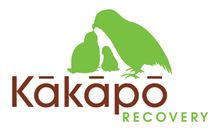Artificial insemination successful for kākāpō
Archived content: This media release was accurate on the date of publication.
Introduction
The future for kākāpō could look more fertile thanks to advancements in artificial insemination.Date: 17 July 2019
This breeding season three female kākāpō were successfully inseminated using artificial insemination (AI) technology, resulting in two chicks. This is the first time that AI has been successful in kākāpō in more than a decade.
DOC Kākāpō operations manager Deidre Vercoe says this is a crucial milestone for the long-term recovery of the species.
"Kākāpō are unusual birds, in that we only see breeding activity every 2-3 years when the rimu trees fruit. Because of high rates of infertility, on their own kākāpō have a very low breeding success rate. In addition, many male kākāpō either never get to breed or only produce few offspring, which worsens the already limited genetic diversity of the species."
"AI provides an opportunity to help fix both of these problems."
AI, funded this year by DOC and Kākāpō Recovery's national partner Meridian Energy, with the support of Ngāi Tahu, is used on kākāpō in an attempt to increase egg fertility and minimise loss of genetic diversity, Deidre says.
"This is part of our efforts to ensure that all founders are genetically represented."
Crucially, one of the chicks produced via AI this year is the offspring of Sinbad, a male who had not yet passed on his rare Fiordland genes. Sadly, his special chick is one of the 13 currently impacted by aspergillosis – the fungal disease which has been threatening the kākāpō population on Whenua Hou/Codfish Island.
"However, this development is still something to celebrate as this is likely to be a crucial tool for the future genetic management of the species."
DOC's Kākāpō Recovery programme began investigating the use of AI for kākāpō breeding in 2002.The first attempt took place in 2008 and in 2009 it was successful – the first time it had worked in a wild bird species worldwide. However, subsequent attempts in 2011, 2014 and 2016 were all unsuccessful.
The latest results are credited to years of refinement of techniques and technology, Deidre says.
Ngāi Tahu representative to the Kākāpō Recovery Group Tane Davis says this success was an example of Western science working alongside traditional Matauranga values for the enhancement of the species.
"The existing kākāpō population has a very limited stream of whakapapa to produce offspring from. The joining of Matauranga and western science perspectives are needed to maintain the kākāpō population, and ultimately enhances the Mauri of kākāpō."
This work was funded by DOC and Meridian, with experienced AI practitioners from Giesen University in Germany joining the kākāpō team on Whenua Hou in February and March.
Meridian Chief Executive Neal Barclay says they are thrilled with the results the AI programme has achieved.
"While this breeding season has been very strong, it hasn't been without considerable challenges. AI provides another way to help ensure the survival of our precious kākāpō and we're very proud to be part of that" says Mr Barclay.
Deidre Vercoe says future advancements in AI will see more and more successes for kākāpō.
"We can be more confident in the ongoing use of AI as a tool in the species' management toolbox."
Contact
For media enquiries contact:
Email: media@doc.govt.nz

